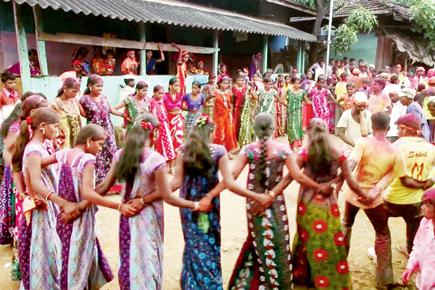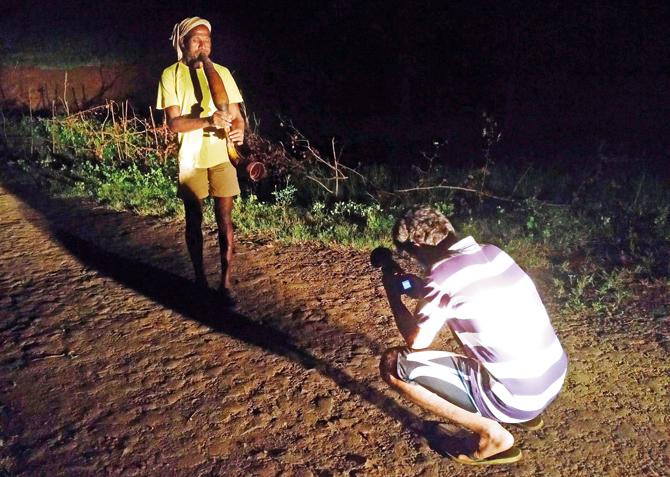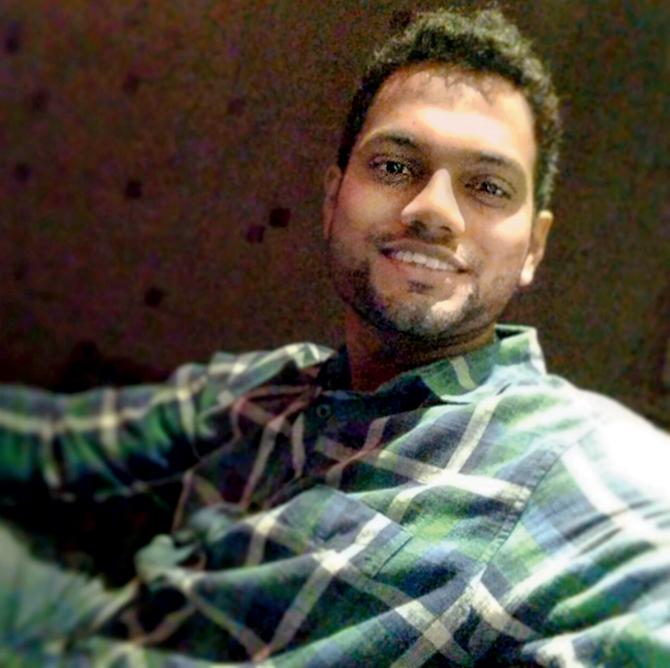A short documentary sheds light on the dying tribal dance that is performed to the tunes of a bamboo-and-bottle gourd instrument


Villagers perform the tribal dance in a circle
ADVERTISEMENT
A drone camera hovers over a cluster of huts that make up Chhas Gaon, a sleepy hamlet in the foothills of the Sahyadris, about 200km from Mumbai. It’s home to several tribes of Maharashtra, including Warlis and Katkaris. In the next few frames, we witness the villagers going about their daily chores — women washing utensils or drawing water from a well, children bathing their siblings outside homes and men making their way to farms. However, the entire village comes alive during the Ganpati festival, as residents — both men and women — form a human chain and perform a tribal dance, tarpa, to hypnotic tunes of the eponymous instrument that resembles a snake charmer’s been (flute).

A local plays the tarpa
“The dance is neither choreographed nor rehearsed. The performers follow a leader, known as Udvya, who coordinates the moves with the tarpakar, who plays the tarpa, on the spot,” narrates artiste Shreyas Desai in the voice-over of the eight-minute documentary, Tarpa. It was uploaded last week on Folk Talkies, a YouTube channel created to delve deeper into the folk culture of India. It is managed by Myriad Arts, a 30-member artiste collective based in Mumbai, launched last year.

A bird's eye view of Chhas Gaon
Discover Chhas Gaon
The idea to document the dance form was born two years ago, when Desai, an HR manager who has been practising folk dance and teaching them at NGOs and schools for over a decade, began learning tarpa from dance teacher Vivek Tamhankar. “My research revealed that Chhas Gaon and Jawhar are the only two regions in Maharashtra that are home to tarpa dancers. They travel across the state, including Mumbai, for performances during Ganpati and Gudi Padwa,” says the 30-year-old, who has conceptualised and scripted the documentary.

Shreyas Desai
Last year, during Ganesh Chaturthi, he led a team — director-editor Sahil Karnik, researchers Tejashree Sawant and Anjali Patil, DOP Vishal Patil and production head Pranali Nimkar — for a five-day, self-funded shoot in the village. They connected with Rajan Vaidya, a local artiste, who helped them get access to the dancers, and also shared the origins of the dance form. “It started in ancient times as a means of community entertainment. There are several traditions associated with it. When a family member dies and relatives are expected from other villages, the locals play the instrument through the night,” shares Desai.
Offering a glimpse into the village, he says, “There are about 200 residents, who earn '2,000 per month and still follow the barter system. There is constant power shortage in the area and many of the night shots were taken with the help of light from smartphones. The villagers are also disciplined. They dance only on special occasions and post sunset, no one is allowed to play the instrument as it disturbs the locals. We were even asked to keep our phones on silent.”
Making the instrument
The documentary also features a local, who showcases how the instrument is handcrafted. Without a particular shape, a tarpa is made from bamboo, dried bottle gourd and honeybee wax. “Due to deforestation, the locals haven’t been able to source materials to make the instrument.
In fact, last year, they pooled in '5,000 to procure the wood that would go into making the instrument. Secondly, many from the younger generation have migrated to cities, and are not interested in upholding the dance form. It’s a dying art,” says Desai. Next, the team plans to focus on the lezim folk dance, and upload at least one such documentary a month.
Log on to bit.ly/2waqUN5
 Subscribe today by clicking the link and stay updated with the latest news!" Click here!
Subscribe today by clicking the link and stay updated with the latest news!" Click here!






